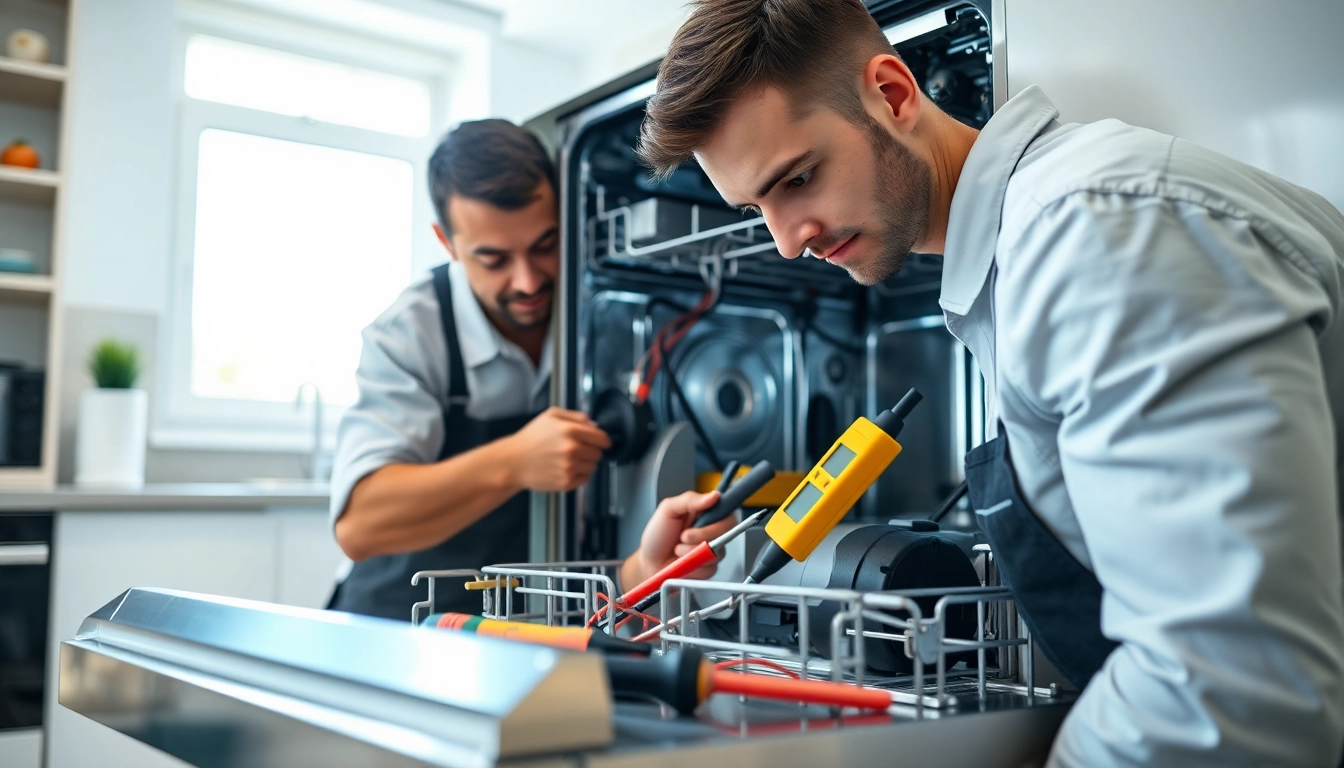Understanding Dishwasher Repair Basics
Dishwashers play a vital role in modern kitchens, streamlining the dishwashing process and saving us time and energy. However, like any appliance, they are susceptible to issues that can interfere with their functionality. Understanding the basics of dishwasher repair is essential for homeowners wanting to maintain this invaluable kitchen helper. Whether it’s a minor glitch or a major malfunction, familiarizing yourself with common problems, necessary tools, and regular maintenance strategies can save you time and money down the line.
Common Issues Faced with Dishwashers
Even the best dishwashers may encounter issues over time. The most frequent problems can range from minor inconveniences to significant repair needs. Understanding these can help in troubleshooting.
- Water Not Draining: One of the most common issues. This could result from a clogged drain hose or filter.
- Dishes Not Cleaning Properly: This can occur because of poor water pressure, blocked arms, or the use of inappropriate detergent.
- Strange Noises: Unusual sounds during operation, often due to a malfunctioning motor, can indicate a problem.
- Leaks: Any pooling water around the dishwashers can stem from damaged door seals or cracks in the appliance.
- Failure to Start: This can be linked to electrical issues, a faulty door latch, or problems with the timer.
- Odors: Bad smells often stem from food particles trapped in the drain or filter.
Tools Needed for Dishwasher Repair
To effectively address these common issues, you’ll need a basic set of tools. Having the right equipment at hand will make your repair process smoother and more efficient:
- Screwdriver Set: Both Phillips and flathead screwdrivers will be necessary for various screws.
- Pliers: Useful for gripping and bending metal parts, especially when dealing with hoses.
- Adjustable Wrench: Needed for any plumbing connections that may require tightening or loosening.
- Towel and Bucket: Essential for cleaning up leaks or spills during repairs.
- Multimeter: Useful for diagnosing electrical problems.
- Brushes and Cleaning Solutions: These are helpful for cleaning filters and parts ensuring better performance.
The Importance of Regular Maintenance
Regular maintenance not only prolongs your dishwasher’s lifespan but also enhances its efficiency. Often, simple tasks can prevent serious issues:
- Cleaning the Filter: Regularly checking and cleaning the filter can prevent clogging, ensuring your dishwasher runs smoothly.
- Inspecting Hoses: Look out for leaks or cracks regularly. Damaged hoses can lead to water pooling around the appliance.
- Wiping Down Rubber Seals: Keeping door seals clean prevents mold growth and ensures a tight fit, which is crucial to avoid leaks.
- Using the Right Detergent: Always choose a detergent compatible with your dishwasher to avoid buildup and residue.
- Running Hot Water Before Cycle: This helps in effective cleaning and prevents stains from setting on dishes.
Step-by-Step Guide to Simple Dishwasher Repairs
Now that you have a grasp of the basics and preventive maintenance, it’s time to delve into some common troubleshooting and repair strategies.
How to Troubleshoot Common Dishwasher Problems
When your dishwasher presents an issue, systematic troubleshooting can help identify the root cause:
- Identify the Problem: Is it cleaning poorly, not draining, or making unusual noises? Define the issue clearly.
- Check Power Supply: Ensure that the dishwasher is getting power. This can be confirmed by checking the plug and circuit breaker.
- Inspect Water Supply: Ensure that the water supply valve is open and that there are no obstructions in the hose.
- Review User Manual: Refer to the manufacturer’s manual as it contains specific troubleshooting steps tailored to your model.
- Check for Error Codes: If your dishwasher has a digital display, see if any error codes are indicated. These can provide clues on what’s wrong.
Repair Strategies for Common Issues
After identifying the problem, you can move into more specific repair strategies based on the issue:
- Dishes Not Cleaning: If cleaning is subpar, inspect and clean the spray arms. They may be clogged or blocked.
- Water Not Draining: For this issue, examine the drain filter and hose for blockages. Clean both areas thoroughly.
- Strange Noises: Noisy operations may require checking for loose parts. Use your tools to tighten or replace any loose components.
- Leaks: For leaks, examine the door seals, drain hose, and water inlet valve. Replace any damaged parts.
- Failure to Start: Clean the door latch and check for power supply issues, often resolving the start problem.
When to Call a Professional for Dishwasher Repair
While DIY repairs can save you money in many cases, certain situations warrant calling in an expert. Here are scenarios where professional help may be necessary:
- When electrical components are at play, such as motors or circuit boards.
- If the issue persists despite your troubleshooting efforts.
- For major plumbing issues, especially if it involves removing your dishwasher.
- If the cost of replacement parts approaches that of a new dishwasher.
- When safety is a concern; dealing with electrical systems can be dangerous without expertise.
Safety Precautions During Dishwasher Repair
Prioritizing safety during repairs is critical. Proper precautions can protect you and ensure that the repair is successful.
Disconnecting Your Dishwasher Safely
Before beginning repairs, you must ensure that the dishwasher is disconnected from power and water sources. Follow these steps:
- Turn off the breaker that supplies power to the dishwasher.
- Unplug the appliance or disconnect it at the outlet.
- Shut off the water supply valve to stop any leaks.
Protective Gear Recommendations
Wearing protective gear during repairs can help prevent injuries. Consider the following:
- Gloves: Wearing rubber gloves can protect your hands from sharp parts and cleaning solutions.
- Safety Glasses: These will shield your eyes from debris and cleaning agents.
- Steel-Toed Boots: During heavy lifting or moving parts, sturdy footwear can protect your toes from injury.
Identifying Hazards in Appliance Repair
Being aware of potential hazards is vital to a safe repair process. Pay attention to:
- Electrical Risks: Live wires can cause severe injury. Always disconnect power when working on electrical appliances.
- Water Hazards: Water pooling around the dishwasher can present slipping dangers. Clean up any moisture promptly.
- Sharp Edges: Handles and parts may have sharp edges; proceed with caution to avoid cuts.
Advanced Techniques for Dishwasher Repair
For more experienced DIYers, advanced repair techniques can further enhance your troubleshooting capabilities and efficiency.
Electrical Components and Troubleshooting
Electrical problems can sometimes be daunting. However, understanding basic components can help you tackle these issues effectively:
- Understanding Circuits: Familiarize yourself with your dishwasher’s circuitry. Knowing where each component is can expedite repairs.
- Using a Multimeter: Measure voltage across terminals to pinpoint faulty components, like timers or motors.
- Replacing Fuses: If your dishwasher has blown a fuse, replace it with the same type to restore power.
Replacing Parts: When and How
Identifying when to replace a part rather than fixing it is crucial for efficiency. Here are common components that may require replacement:
- Spray Arms: If damaged or clogged, replacing these arms can restore proper cleaning.
- Door Seals: Signs of wear on seals may cause leaks, requiring a quick swap-out.
- Water Inlet Valve: If your dishwasher isn’t filling with water, this valve might need replacing.
- Filters: Regularly replace filters that show signs of wear or can’t be cleaned effectively.
Upgrading Your Dishwasher for Better Performance
In addition to repairs, upgrading certain components can enhance your dishwasher’s overall performance:
- High-Efficiency Parts: Consider replacing old components with high-efficiency options for better water and energy savings.
- Smart Technology: Upgrading to smart technology can improve usability and diagnostics, making it easier to manage issues.
- Noise Reduction Kits: Installing sound-dampening kits can significantly reduce noise levels during operation.
Maximizing Efficiency: Maintenance Tips for Dishwashers
Once your dishwasher is up and running at its best, maintaining its efficiency is key.
Best Practices to Ensure Longevity
Implementing best practices in care and usage can significantly extend the life of your dishwasher:
- Always Load Correctly: Follow the manufacturer’s loading guidelines for optimal cleaning.
- Run Full Loads: To save water and energy, only run the dishwasher with a full load.
- Regular Cleaning: Maintain cleanliness of the interior and exterior to prevent buildup and odors.
Saving Water and Energy During Use
Being mindful of your water and energy consumption impacts both your wallet and the environment:
- Use Eco Modes: Most modern dishwashers come with eco-settings that optimize resource use.
- Adjust Heat Settings: Sometimes, lowering the heat setting can still yield effective cleaning without excessive energy use.
Signs You Need a Dishwasher Repair vs. Replacement
Distinguishing between when to repair and when to replace your dishwasher can affect your long-term costs:
- Age of Dishwasher: If your unit is more than 10 years old, consider replacement.
- Cost of Repairs: If repairs approach 50% of the cost of a new unit, replacement may be more economical.
- Ongoing Problems: If you find yourself repairing the same issue repeatedly, it’s often a sign of a larger problem.



